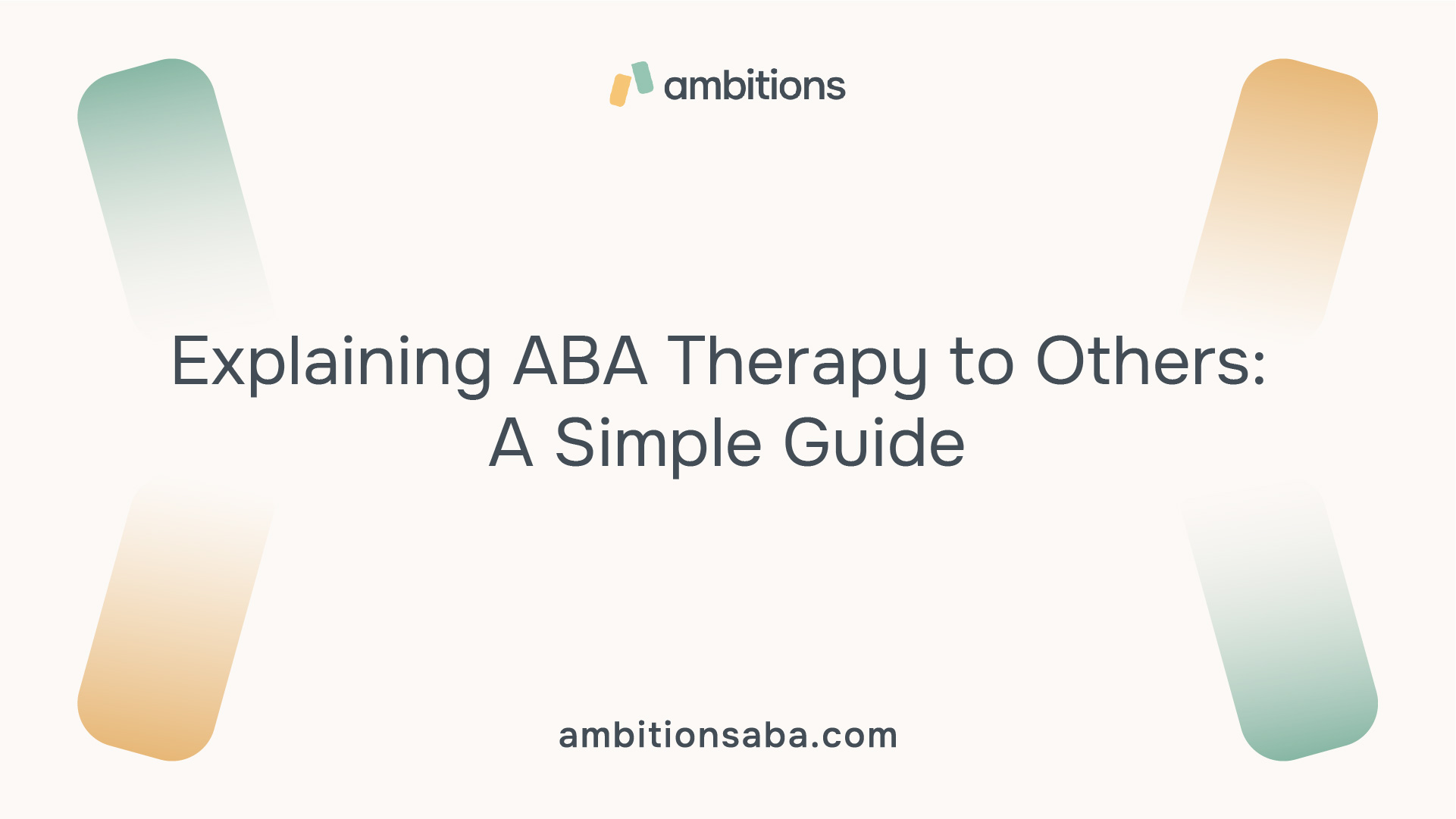Unlocking Behavioral Insights Through FBA in ABA Therapy
Understanding ABA Therapy
Explaining Applied Behavior Analysis (ABA) therapy to others can be straightforward when the foundation is known. Parents of children diagnosed with autism often seek to understand this therapy better to share its benefits and principles with family and friends.

Basics of ABA Therapy
ABA therapy is a structured approach aimed at helping individuals with autism develop essential skills and positive behaviors. It is based on the principles of behaviorism and the work of psychologist B.F. Skinner, focusing on operant conditioning—modifying behavior by adjusting the consequences, such as rewards and punishments.
The essence of ABA involves teaching children to connect actions with outcomes. By employing positive reinforcement, therapists encourage desirable behaviors while discouraging negative ones. Positive reinforcement can involve social praise, access to preferred items, or sensory experiences.
Key components of ABA include:
ComponentDescriptionOperant ConditioningModifying behaviors through consequencesPositive ReinforcementEncouraging desired behaviors using rewardsDiscrete Trial TrainingTeaching one skill at a time with clear instruction, response, and feedback
Principles of ABA Therapy
Several core principles guide ABA therapy, helping to create effective strategies tailored to individual needs. These principles include:
Understanding these principles helps parents convey the structure and focus of ABA therapy to others, highlighting its role in developing essential life skills for children with autism.
For further insights on early diagnosis and how to effectively manage routine changes, check out the importance of early autism diagnosis and how to handle changes in routine for autism?.
Benefits of ABA Therapy
Positive Outcomes of ABA
Applied Behavior Analysis (ABA) therapy has shown remarkable positive outcomes for children diagnosed with autism. Research indicates that children engaged in intensive, long-term ABA therapy—typically ranging from 25 to 40 hours per week over one to three years—demonstrated significant improvements across various domains. These enhancements included:
Area of ImprovementPercentage of Participants Showing GainsIntellectual Functioning40-60%Language Development60-80%Daily Living Skills50-70%Social Skills70-90%
This data highlights the effectiveness of ABA as an evidence-based best practice treatment for autism. As reported by Autism Speaks, intensive programs built on ABA principles can foster gains in crucial areas, enhancing daily experiences for the child.
Moreover, ABA therapy is beneficial even if a child does not fully lose their diagnosis or does not transition into mainstream educational settings. It assists in teaching essential life skills, promoting independence, and developing language proficiency.
Advantages for Adults with Autism
ABA therapy extends its benefits beyond childhood, proving advantageous for adults with autism. Adults engaging in ABA therapy have found it instrumental in learning vital skills needed for daily living and workplace success.
The therapy focuses on:
The application of ABA principles equips individuals with the tools they need to function effectively in society, thereby improving their overall quality of life. As families consider ABA therapy, understanding its advantages for their children and its lifelong impact can be vital in explaining how to explain ABA therapy to others?
Individualized Approach in ABA Therapy
A key feature of ABA therapy is its personalized approach tailored to meet the unique needs of each child diagnosed with autism. This individualized focus ensures that therapy plans are effective and relevant.
Personalized Therapy Plans
Each child undergoing ABA therapy has a plan designed specifically for them. These plans are not one-size-fits-all; instead, they are created by qualified behavior analysts who take into account the child’s skills, interests, and family situations [4]. The individualized goals and benchmarks are set based on the child's specific struggles and strengths.
Components of a Personalized PlanDescriptionSkills AssessmentEvaluating the child's current abilities and challenges.Goal SettingEstablishing achievable goals tailored to the child's needs.Progress MonitoringRegular review of the child's development towards goals.Family InvolvementEngaging family members in the planning and support process.
Through these detailed plans, children receive targeted support that promotes their independence and success.
Adaptation to Child's Needs
ABA therapy is inherently flexible and adapts to the child’s needs during therapy sessions. As the child progresses, the therapy can shift focus to address new skills or challenges arising from different environments, such as school or social settings. This adaptability is essential in helping children understand social norms and be prepared for various situations.
For example, if a child struggles with communication in a group setting, the therapy can adjust to include more social interaction exercises. The use of positive reinforcement plays a significant role here, encouraging kids to engage in desired behaviors by rewarding them for their achievements. Rewards like praise or small incentives can motivate children to reach their goals, reinforcing positive behavior change.
This individualized and adaptive approach is what makes ABA therapy effective in providing children with the support they need to thrive. For parents wanting to learn more about related topics, articles like the importance of early autism diagnosis and how to teach coping skills in autism? might be helpful resources.
Success Stories and Studies
Understanding the impact of ABA therapy involves looking at both personal success stories and scientific research. These aspects help convey the efficacy of this therapy to those asking, "how to explain ABA therapy to others?"
Positive Results of ABA Therapy
Many studies have illustrated the positive outcomes for children undergoing ABA therapy. For example, children who participated in intensive sessions, receiving 25 to 40 hours per week for one to three years, showed remarkable improvements in crucial skill areas. The chart below summarizes key areas of positive change observed through ABA therapy:
Skill AreaImprovement ObservedSocial InteractionsSignificant increase in engagement with peersNew SkillsEnhanced learning of essential life skillsPositive BehaviorsGreater maintenance of constructive behaviorsSkill TransferEffective application of learned skills across contextsReduction in Negative BehaviorsNotable decrease in disruptive and harmful behaviors
Studies have shown that children receiving extensive ABA therapy from an early age, particularly before age 4, are more likely to experience these benefits [6].
Study Findings on ABA Efficacy
Numerous studies have backed the effectiveness of ABA therapy as an evidence-based treatment for autism. According to research published in reputable journals, including the Journal of Applied Behavior Analysis, ABA interventions significantly improve various developmental areas. One comprehensive study revealed:
Area of DevelopmentABA Therapy OutcomeIntellectual FunctioningProfound gains in cognitive abilitiesLanguage DevelopmentNotable progress in verbal communication skillsDaily Living SkillsImprovement in self-sufficiency and independenceSocial FunctioningEnhanced ability to interact socially
Extensive applications of ABA principles are essential for achieving these positive outcomes. This scientific backing places ABA therapy firmly as a cornerstone in treating autism, allowing parents of children diagnosed with autism to advocate effectively for their children’s needs.
For more information on how ABA therapy can benefit your child, it's crucial to explore ongoing studies and success stories from other families navigating similar challenges.
ABA Techniques
Understanding ABA therapy involves familiarizing oneself with various techniques that effectively help children diagnosed with autism. These techniques focus on modifying behavior using specific strategies to foster positive outcomes.
Key ABA Strategies
Here are some essential strategies commonly used in ABA therapy:
Strategy NameDescriptionPositive ReinforcementThis technique increases desirable behaviors by providing a reward, such as social attention or access to favorite items.Negative ReinforcementAims to eliminate unpleasant stimuli, which increases the likelihood of specific behaviors. This strategy focuses on teaching children adaptive behaviors to escape aversive situations [2].Discrete Trial Training (DTT)Involves a systematic approach to teach new skills by breaking tasks down into single opportunities, using clear prompts and feedback.Natural Environment Teaching (NET)Encourages learning through play and daily activities, enhancing functional skills that can be generalized effortlessly.ShapingThis method reinforces gradual approximations toward a specific behavior, supporting the learning of more complex skills by breaking them into smaller steps.
Practical ABA Applications
Parents often wonder how to implement these strategies effectively. Practical applications include:
These strategies can be integrated into daily life, leading to significant advancements for children with autism. For more resources related to supporting children with autism, explore our guides on how to teach coping skills in autism? and best summer camps for autistic kids.
ABA Therapy Implementation
Understanding how ABA therapy is implemented can provide clarity for parents navigating the process. It involves setting clear therapy procedures and goals, as well as ensuring family involvement and support.
Therapy Procedures and Goals
ABA therapy enables a customized approach focused on the specific needs of each child. Personalized plans are created for individuals undergoing ABA therapy, which sets individual goals based on the specific struggles experienced by each child. These plans are not one-size-fits-all; they are designed by a qualified behavior analyst who oversees the program.
During therapy sessions, the goals may include developing essential skills for independence and communication. Techniques employed in ABA therapy include Discrete Trial Training (DTT), which breaks skills into smaller units for focused learning, and Modeling, where desired behaviors are demonstrated for imitation. Another essential technique is the Picture Exchange Communication System (PECS), which aids in teaching communication through visual prompts.
Here’s a brief overview of common therapy goals within ABA:
Goal CategoryExample GoalsCommunicationImprove language skills by teaching vocabularySocial SkillsEnhance interaction opportunities with peersDaily Living SkillsDevelop self-care routines like dressing and hygieneBehavioral ComplianceIncrease adherence to household rules
The therapy is adaptable, allowing for adjustments based on ongoing assessments of the child’s progress. It encourages children to learn at their own pace with sessions often starting in the home environment.
Family Involvement and Support
Family involvement is a critical component of ABA therapy. Parents and caregivers play a significant role in reinforcing the skills learned during therapy sessions. It is essential for families to be educated about the strategies being employed, as they help to create a consistent learning environment at home. This support enhances the effectiveness of ABA therapy and contributes positively to a child's development.
Families can experience various benefits from being actively involved, including:
For parents seeking further guidance, it's advised to explore resources on how to handle changes in routine for autism? and learn about how to teach coping skills in autism?.
The collaboration between therapists and families is fundamental to achieving the goals set within the ABA therapy framework. By working together, they can ensure a strong support system for the child, which can significantly influence the success of the therapy.
References
[2]:
[3]:
[4]:
[5]:
[6]:

